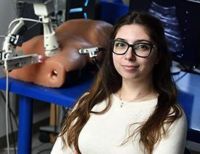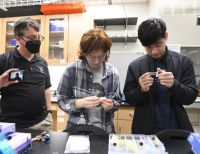People with certain conditions, such as diabetes or high blood pressure, are often advised to improve their diets to control symptoms and deter progression of their ailments. But many find themselves unable or unwilling to follow a rigid "one-size-fits-all" nutrition plan recommended by their doctors because those approaches do not always take into account patients' food preferences and habits.
According to a Johns Hopkins systems engineer, diets customized to individual patients' tastes and habits via an artificial intelligence learning process called "inverse optimization" might hold the key to ultimately helping people make healthier food choices.
"The idea is not to just tell the patient what they ideally should be eating," says Kimia Ghobadi, an assistant professor in the Department of Civil and Systems Engineering at the Whiting School of Engineering. "Instead, we need to factor in the patient's preferences, lifestyle, and previous choices to figure out what their best achievable diet is."
Kimia Ghobadi
Assistant professor at the Whiting School of Engineering
"The idea is not to just tell the patient what they ideally should be eating. Instead, we need to factor in the patient's preferences, lifestyle, and previous choices to figure out what their best achievable diet is."
Unlike traditional optimization, which uses mathematics to model a decision-making process and find the best possible decision, inverse optimization uses past decisions to learn what the mathematical model should be to replicate the decision-making process in question. For instance, in the case of a person making choices about what they should eat to improve their health or manage a condition, the constraints (what they should do) are clear, but how they eat in real life is not. Inverse optimization can help shed light on those preferences based on the individual's past decisions.
Ghobadi's model currently uses data from the Center for Disease Control's National Health and Nutrition Examination Survey, which includes information about the habits of about 5,000 people across the country.
Her approach combines the ideal (what patients should be doing to lower their salt or sugar intake or increase their fiber or protein, for instance) with the practical (what they actually do each day). The result is a set of suggested plans that start with foods that align closely with patients' daily habits and, over time, guide them in the direction of achieving more nutritionally healthy goals.
"We basically help them find a diet that is healthy and yet as close as possible to what they are already doing day to day," Ghobadi says. "Then we add suggestions to help patients approach the ideal while still keeping it palatable to them and a fit for their lifestyle, including how long it'll take to prepare food. That ups the chance that patients will be successful and adhere to the diet long term."
The diets recommended over time would be provided to patients at the beginning, so they understand the steps they will take toward a healthier regimen, according to Ghobadi.
"Then it is up to them—and their doctors—to decide when to switch from a more forgiving diet to a more ideal one," she says. " In this way, the optimized diet serves as a path and set of options that respects the patient and their food habits but also guides them toward achieving healthier nutritional goals. They know what is coming each step of the way. And we can run the mathematical models again to adjust things as they go along if their behavior and habits change."
Ghobadi envisions that this approach to diet planning and modification may eventually be available to customers via an app, but in the meantime, she and her team are currently working with patient populations and developing an interactive website that will allow them to try out their customized diets by logging on and reviewing sample dietary paths based on available data.
"The goal is to enable diet personalization that is data-driven, and this is a first step," Ghobadi says.
Ghobadi is working with doctoral candidates Farzin Ahmadi and Fardin Ganjkhanloo in the Civil and Systems Engineering Department, and Tinglong Dai, a professor at Johns Hopkins Carey Business School on the project.







